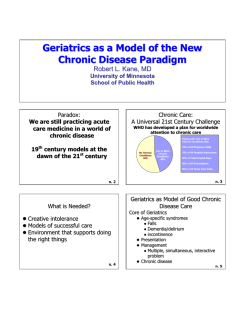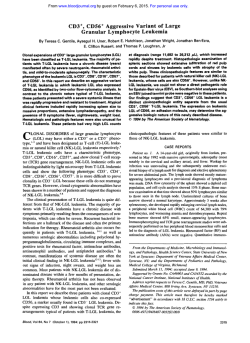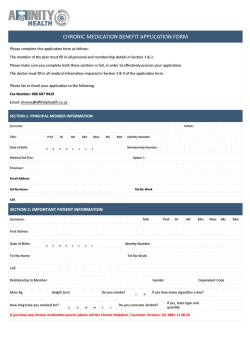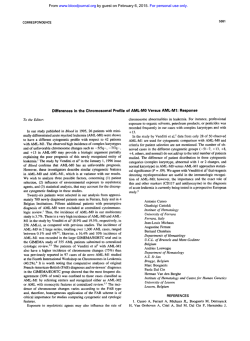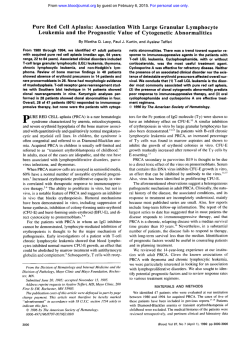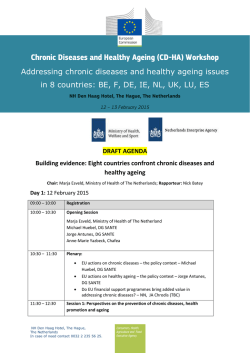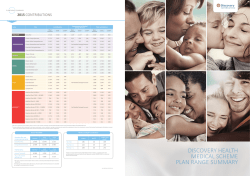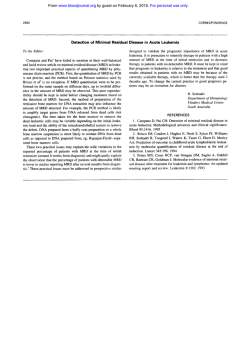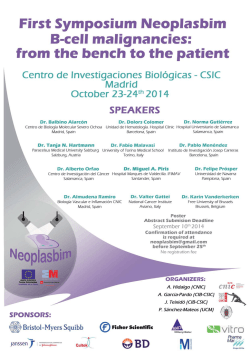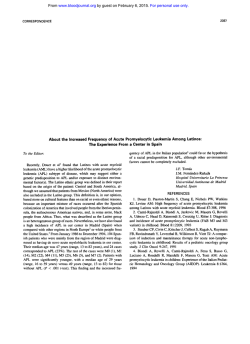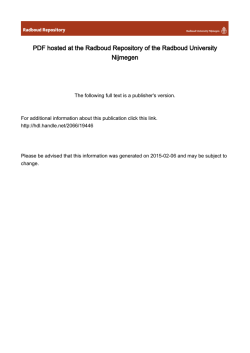
Chronic Natural Killer Cell Lymphocytosis: A Descriptive
Chronic Natural Killer Cell Lymphocytosis: A Descriptive Clinical Study By Ayalew Tefferi, Chin-Yang Li, Thomas E. Witzig, Madav V. Dhodapkar, Scott H. Okuno, and Robert L. Phyliky We review the clinical manifestations and long-term outlook of patients with chronic natural killer (NK) cell lymphocytosis. After reviewing more than 1,500 peripheralblood lymphoid flow cytometry reports andmoleculargenetics data from patients with suspected large granular lymphocyte (LGL) proliferation, we identified 10 patients (median age at diagnosis, 60years; range,35 to 76 years; ma1e:female ratio, 3 2 ) with persistent (greaterthan 6 months) increasein phenotypically determined NK cells (CD3-CD16’). Southern blot analysis performed on 9 patients showed no clonal Tcell receptor gene rearrangements. Disease duration was measured from time of initial recognition of LGL or NK cell excess (greater than 40% of the lymphocyte fraction). Clini- cal data from these 10 patients were compared with those from 68 patients with T-cell LGL (T-LGL)leukemia. Currently, all patients arealive (median diseaseduration, 5 years; range, 0.8 to 8 years). Associated disease manifestations included purered blood cell aplasia, recurrent neutropenia, recurrent neutropenic sepsis, and vasculitic syndromes, all of which were responsive to immunosuppressive therapy. No patient had palpable lymphadenopathy or splenomegaly. Compared with the patients with T-LGL leukemia, patients with chronic NK cellleukemiahadsimilarlymphocyte counts,associatedconditions, treatment responses, and survival but had less neutropenia and anemia. 0 7994 by The American Societyof Hematology. Q NK cells normally constitute approximately 15% of the mononuclear cells in PB. Therefore, a proportion exceeding the mean value by 2 standard deviations (40%) was used as a cutoff value to define excess LGL or NK cell populations. NK cells were defined as nonT andnon-B lymphocytes expressing NK cell antigen markers (CD3-CD16+). Mononuclear cell phenotypic analysis, h X cell cytotoxicity assays, NK cell cultures, and T-cell antigen receptor gene rearrangement studies were performed according to previously described methods.“.” An immunoperoxidase stain for CD57 (Leu-7, another NK cell marker) wasused to identify NK cells inbone marrow (BM) biopsy specimens. Study patients were analyzed for presenting clinical and laboratory features, clinical course, treatment outcome, and associated disease manifestations (Table 1). Survival was measured from the time an excessive NK cell fraction or LGL population was initially recognized in a PB smear. Treatment response measurements included complete remission (resolution of symptoms and normalization of blood cell counts and NK cell fractions in PB) and partial remission (resolution of symptoms or cytopenia together with a greater than 50% decrement in lymphocytosis without documented normalization of NK cell fraction). Finally, the clinical data from patients with chronic NK cell lymphocytosis were compared with the data from 68 patients with TLGL leukemia observed at our institution during the study period. The Mann-Whitney statistic was used to compare age distributions, hemoglobin values, absolute neutrophil counts, white blood cell counts, and absolute lymphocyte counts. The x* statistic was used to compare symptom or disease associations. UANTITATIVE abnormalities of large granular lymphocytes (LGLs) are not uncommon and may represent a transient phenomenon associated with viral infections or a chronic lymphoproliferative disorder characterized by chronic neutropenia.”’ The lymphocytes in proliferations of LGLs carry the phenotypic characteristics of either T cells (CD3+CD16+)or natural killer (NK) cells (CD3-CD16t)?4 In the former subset, clonality can be determined by T-cell antigen receptor gene rearrangement studies,’ which are not applicable to NK celIs.6 On the basis of the phenotypic profiles and the clonal nature of the expanded lymphocyte population, the following terms have been proposed.’ LGL proliferations of T cells with demonstrable clonal T-cell antigen receptor gene rearrangements are referred to as “T-LGL leukemia.” LGL proliferations of NK cells with clonal cytogenetic abnormalities are referred to as “NK-LGL leukemidymphoma.” Clinically, T-LGL leukemia is usually an indolent chronic condition associated with neutropenia and responsive to immunosuppressive therapy.’.’ By contrast, NK-LGL leukemid lymphoma isan aggressive lymphoproliferative disorder with multiorgan involvement and short survival LGL proliferations of NK cells cannot always be classified as NK-LGL leukemidymphoma. In our experience and that of others, a persistent increase in peripheral NK cells is often associated with a more indolent chronic disease similar to TLGL Unlike the case with NK-LGL leukemid lymphoma, the clonal nature of chronic NK cell lymphocytosis is a matter of contr~versy?.~~.’~ Herein, we describe the clinical spectrum and long-term outcome associated with chronic NK cell lymphocytosis. RESULTS Patient selection. A total of 10 patients with chronic NK cell lymphocytosis were identified. Detailed immunophenotypic studies were performed in all patients (NK cells in PB: median cell fraction, 68%; range, 42%to 83%). In addition, MATERIALS AND METHODS Patients were identified from several sources including a review of more than 1,500 peripheral blood (PB) lymphoid flow cytometry reports obtained at our institution during the last 5 years and a review of molecular genetics data obtained from patients with suspected proliferations of LGLs. Patients were considered to have chronic NK cell lymphocytosis after demonstration of persistent (greater than 6 months) NK cell excess (evaluated with lymphoid flow cytometry) or LGL excess (evaluated with PB smear and subsequently phenotyped as NK cell excess by lymphoid flow cytometry). In addition, eligibility for this study included the absence of viral infections and medications known to influence lymphocyte subset distribution and number. Blood, Vol 84, No 8 (October 15), 1994 pp 2721-2725 From the Division of Hematology and Internal Medicine and the Division of Hematopathology, Mayo Clinic and Mayo Foundation. Rochester, MN. Submitted March 31, 1994; accepted June 23, 1994. Address reprint requests to Ayulew Tefferi, MD, Mayo Clinic, 200 First Street SW,Rochester, MM 55905. The publication costs of this article were defrayed in part by page charge payment. This article must therefore be hereby marked “advertisement” in accordance with 18 U.S.C. section 1734 solely to indicate this fact. 0 1994 by The American Society of Hematology. 0006-4971/94/8408-0039$3.00/0 2721 TEFFERI ET AL 2722 Table 1. Clinical Features of 10 Patients With Chronic NK Cell Lymphocytosis Patient No. Age (yrl Sex 1 2 63 69 M 3 37 M 4 5 6 35 45 64 F M 7 36 58 76 66 M 8 9 10 F F Associated Diseases None Neutropenia, anemia Severe constitutional symptoms vasculitis Skin Fever and AGN PRCA H& Survival WdL) WBC (no.lpL) ANC (no./wL) (%l Therapy Response (yr) 13 8.2 2,800 5,400 520 240 64 68 None Pred, CTX 1.5t 5.5+ 16.4 15,300 7,500 83 Pred, CTX NA NR CR NR NR 13.1 12 7.7 1 1,000 2,500 3,500 1,600 75 42 66 Pred Pred Pred, Aza PR PR PR CR 5t 8+ 2,900 NA68 NA 68 8,800 2,900 None 4,000 12,000 15.8 M None 8,900 16.5 vasculitis F Skin 5,30015,200 15.9 51 M Cyclic 100 2,200 10.2 neutropenia NK 74 None None NSAlDs CTX NR PR 2t 6+ 4t 0.8t l+ 2.5+ Abbreviations: AGN, acute glomerulonephritis; ANC, absolute neutrophil count; Aza, azathioprine; CR, complete remission; CTX, oral cyclophosphamide; Hgb, hemoglobin; NA, not applicable; NK, NK cells; NR, no response; NSAIDs, nonsteroidal antiinflammatory agents; PR, partial remission; PRCA, pure RBC aplasia; PRED. prednisone; WBC, white blood cellcount. molecular genetic studies were performed in all but 1 patient and showed no clonal T-cell antigen receptor gene rearrangements. Patient characteristics and physical jindings. The median age of the patients was 60 years (range, 35 to 76 years), and the male-to-female ratio was 3:2. The median duration of disease was 5 years (range, 0.8 to 8 years; see Table 1). None of the patients had palpable lymphadenopathy or splenomegaly at diagnosis, and palpable splenomegaly developed in only l patient during the course of the disease. Associated disease manifestations and symptoms. At the time of initial immunophenotypic analysis, associated disease manifestations included pure redblood cell (RBC) aplasia ( l patient), recurrent neutropenia, recurrent neutropenic fever sometimes associated with pneumonia or bacterial cellulitis ( 2 patients), and vasculitic syndromes (3 patients; see Table l). Of the 4 other patients, 3 were asymptomatic and 1 had severe constitutional symptoms, including arthralgias, myalgias, night sweats, and low-grade fever (patient no. 3). The patient with pure RBC aplasia was RBC transfusion-dependent, with a reticulocyte count of O S % , a leukocyte count of 2.9 X 103/pL,and a leukocyte differential count of 56% segmented neutrophils and 35% lymphocytes. Examination showed that the BM was hypercellular, with quantitative decrease in erythropoiesis. Both granulopoiesis and megakqopoiesis were increased, and there was a left-shifted erythropoiesis with maturation arrest. The vasculitic syndromes included urticarial vasculitis, acute glomerulonephritis and fever, and cutaneous polyarteritis nodosa. The patient with acute glomerulonephritis had a renal biopsy specimen that showedacute necrotizing glomerulonephritis. The patient with urticaria had slightly indurated erythematous patches measuring 0.5 to 1 cm. The skin biopsy specimen showed leukocytoclastic vasculitis with eosinophilic granule debris. The patient with cutaneous polyarteritis nodosa had persistent livedo and painful leg ulcers. The biopsy specimen showed neutrophilic vascular inflammation consistent with periarteritis nodosawith impetiginization. Comorbid conditions included rheumatoid arthritis in I patient (patient no. 10) and severe diabetic neuropathy in another (patient no. 8). Laboratory findings. In addition to the required CD3-CD16' phenotype, the NK cells displayed a CD2+CD8- phenotype in all cases. HLA-DR was expressed in all but 1 patient (patient no. 9); CD7 was expressed in 8 of the 10 patients (patients no. l and 10, CD7-; see Table 1). A total of 2 patients had anemia attributable to chronic NK cell lymphocytosis, and 1 was transfusion-dependent (patient no. 6; see Table 1). Two patients had mild progressive thrombocytopenia (patients no. 1 and 9). Neutropenia (absolute neutrophil count less than 1,5OO/pL) was observed in 3 patients (Table 1). The median white blood cell and absolute lymphocyte counts were 8,85O/pL (range, 2,200 to 15,300) and 4,9OO/pL (range, 1,000 to 7,500), respectively. The PB smear showed excess LGLs in all but I patient (median LGL fraction in patients with excess LGLs was 60%; range, 48% to 74%; see Figs 1A and B). NK cell excess in the 1 patient without obvious LGL excess in PB was shown by immunophenotypic analysis (patient no. 6). BM from 7 patients was examined, and the pattern of LGL infiltration was always interstitial and was not easily recognizable. Immunoperoxidase staining of BM biopsy specimens with CD57 (Leu-7) was useful in visualizing the interstitial LGL infiltration (Fig IC). Occasionally, a few non-NK cell lymphoid aggregates were noted (Fig 1D).In addition, pure RBC aplasia and myeloid maturation arrest were seen in patients no. 6 and 10, respectively. Cytogenetic studies were performed in 5 patients and showed no clonal abnormalities. Additional laboratory studies included negative results on granulocyte antibody tests in the 3 patients with neutropenia, negative findings on cell-bound platelet antibody test in 1 patient with thrombocytopenia, polyclonal gammaglobulinemia in 3 patients, andnormalfindings on liver function CHRONICNATURAL KILLER CELLLYMPHOCYTOSIS 2723 Fig 1. PB m e a m showing Uib either with Wright-Giemsa stain (AI or immunoperoxidase stain for CD57 (Leu-7; ID). (C) BM biopsy with CD57 immunoperoxidase stain revealing 'interatltial pattern 'of large granular lymphocyttc infilWation.(D)Benign lymphoid aggregatefree of large granular Lymphocytic infiltration. tests in all patients. Rheumatoid factor assay and antinuclear penic fevers developed. The patient had partial remission antibody test were performed in 5 and 6 patients, respecwith cyclophosphamide administered orally. Similarly, the tively, and the results were positive only in the patient with patient with pure RBC aplasia had partial remission with rheumatoid arthritis (patient no. 10). corticosteroid treatment and subsequently achieved a durable Cytotoxicity assays were performed in 2 patients (patients complete remission with azathioprine. Despite treatment that no. 2 and 3) and showed marked activity in both direct NK lasted for only 1 to 11 months, cytopenia has not recued cell-mediated cytotoxicity and antibody-dependent cellular in these 3 patients, who have been followed up for 1,4, and cytotoxicity. In addition, the NK cells from 1 ofthese 2 more than 5 years. Neither the symptoms nor the laboratory patients (patient no. 2) had altered in vitro growth requireabnormalities responded to either corticosteroids or cycloments, suggesting that these cells did not represent a polyphosphamide in the patient with constitutional symptoms. clonally expanded population ofnormal NK cells. SubseComparison withpatientswith T-LGL leukemia. During quentX-linked DNA analysis in this patientshowed a the studyperiod, we also saw a series of68collseeutive patients monoclonal pattern of X-chromosome inactivation.'* with T-LGL leukemia.I6 We compared several clinical variables, including presenting clinical Treatment outcome. Six patients requiredimmunosuppresfeatures,laboratory findings, sive therapy for vasculitic syndromes (2 patients), symptomatic mbnent outcome, and survival, between patients with chronic neutropenia (2 patients), pure RBC aplasia (1patient), or constiNK cell lymphocytosis and those with T-LGL leukemia. No tutional symptoms (1 patient; see Table 1). In the 2 patients sigdicant differences were observed with regard to age, sex, with vasculitic syndromes, corticosteroid therapy resulted symptoms, white blood cell count in ( P = .14), absolute lymphoamelioration of symptoms and signs of vasculitis. In addition, cytecounts (P = .37), treatmentmsponses,orsurvival. In both patients had documented partial hematologic remissions. contrast, patients with chronicNK cell lymphocytosis showed Treatment with corticosteroids failed to resolve the symp-less neutropenia (P = .03) and anemia (P = M). tomatic neutropenia in patient no. 2, but hematologic comDISCUSSION plete remission was achieved with cyclophosphamide administered orally. Patient no. 10 was receiving treatment with NK cells are defined operationally as a subpopulation of prednisone for rheumatoid arthritis when recurrent neutrolymphocytescarryingthemembranephenotype,CD3- 2724 CD16+, and expressing nonmajor histocompatibility-restricted cytotoxicity without previous sensitization.“Normally, NK cells constitute approximately 15% of the PB mononuclear cell fraction. Morphologically, they appear similar to T-suppressor lymphocytes, with abundant cytoplasm and azurophilic cytoplasmic granules (Fig 1A). Because of this morphologic similarity, disorders ofNK cell proliferation are categorized as a subset of LGL proliferative disorders, which also include T-cell disorders.’ However, as shown by 1 of our patients and previously appreciated by others,’.’7 NKcells are not always discernible as LGLs. Therefore, it might be more appropriate to use a less restrictive terminology such as “NK cell proliferative disorders.” This has direct clinical relevance, because suspected NK cell disorders may need to be evaluated with both PB smear examinations and immunophenotypic analysis. The amount of information available about the spectrum of clinical conditions associated with NK cell proliferations is limited.’ Similarly, the clonal nature of persistent NK cell proliferations is not always evident. Nevertheless, at least two clinical disorders characterized by persistent NK cell proliferations have been recognized.‘ The first, operationally defined as “NK-LGL leukemiallymphoma,” affects relatively younger patients and is characterized by an acute systemic disease with multiorgan involvement, severe constitutional symptoms, and short survival.’.’’ The clonal nature of this disease has been confirmedby the demonstration of clonal cytogenetic abnormalities’ or single episomal form of Epstein-Barr virus DNA in the leukemic ~el1s.I~ A causative role for Epstein-Barr virus in disease pathogenesis or transformation has been ~uggested.’’~’~ The second NK cell disorder, which we refer to as “chronic NK cell lymphocytosis,” has a more indolent disease course similar to that of T-LGL leukemia.’,” Unlike NK-LGL leukemiallymphoma, the results of cytogenetic studies are only occasionally abnormal.’.” Similarly, T-cell antigen receptor gene rearrangement studies are not helpful in the clonal determination of chronic NK cell lymphocytos k 6We showed monoclonality with X-linked DNA analysis in 1 of our patients,” an observation supported by some” but not by others.’ Regardless, in the majority of patients with chronic NK cell lymphocytosis, the clonal nature of the disorder is uncertain. An overview of our experience with 10 patients with chronic NK cell lymphocytosis described herein indicates that patients with this disorder can expect prolonged survival but that their disease may be associated with life-threatening cytopenia or severe vasculitic syndrome. These complications were usually responsive to immunosuppressive therapy; cyclophosphamide administered orally was the most useful agent. Similar to earlier reports,” 1 of our patients had severe constitutional symptoms (fatigue, arthralgias, night sweats, weight loss, fever) unresponsive to therapy. The heterogeneity in clinical manifestations may be related partly to the phenotypic and possibly functional diversity of the excess NK cell populations.’’ Regardless, it may be clinically helpful to include chronic NK cell lymphocytosis in the differential diagnosis of unexplained cytopenias, vasculitic syndromes, and persistent constitutional symptoms. TEFFERI ET AL The observed clinical remissions were associated with a significant decrease in the number of NK cells, suggesting a causative role in disease manifestation. NK cells have been showntohave a negativeregulatorycontrolon erythropoiesis” and, thus, could suppress in vitro erythroid colony f~rmation.’~ Similarly, the associated neutropenia may be secondary to an interleukin-2-induced cell-mediated suppression of myeloid progenitors possibly involving y interfer~n.’~ Alternatively, it may involve a functional deficiency of myeloid colony-stimulating factors mediated by humoral rne~hanisms.’~ The latter supposition is supported by reports of successful treatment of T-LGL leukemia-associated neutropenia with colony-stimulating fact~rs.’~~’’Although abnormal B-cell function has not been studied in chronic NK cell lymphocytosis, their abnormal function that results in autoantibody production has been implicated in T-LGL leukemia as the pathogenetic basis for associated autoimmune diseases.” The durable remissions observed with cyclophosphamide taken orally are similar to those reported in patients with TLGL le~kemia.’.~~.’~ We previously reported on a successful immunosuppressive therapy with corticosteroids and azathioprine in a patient with pure RBC aplasia associated with chronic NK cell 1ymphocytosis.’’ Although some patients responded to corticosteroid therapy, remission depended on continued administration of high doses of the drug. Comparative clinical data between patients with chronic NK cell lymphocytosis and those withT-LGL leukemia showed similar epidemiologic and clinical features, including the spectrum of associated disease manifestations and survival. The only differences were lesser incidences of anemia and neutropenia in patients with chronic NK cell lymphocytosis and a higher incidence (26%) of rheumatoid arthritis in patients with T-LGL leukemia.16 Although acute transformation into a clinically more aggressive disease was not observed in our patients, it has been reported with chronic NK cell lymphocytosis.’,30 REFERENCES 1 . Scott SS, RichardsSJ,SivakumaranM,Short M, ChildJA, Hunt KM, McEvoy M, Steed M , Balfour IC, Parapia LA, McVeny BA, Bynoe AG,Galvin MC, Norfolk DR, RobertsBE:Transient and persistent expansions of large granular lymphocytes (LGL) and NK-associated (NKa) cells: The Yorkshire Leukaemia Group study. Br J Haematol 83504, 1993 2. Loughran TP: Clonal diseases of large granular lymphocytes. Blood 82:1, 1993 3. Bray R A , Gottschalk LR, Landay AL. Gebel HM: Differential surface marker expression in patients with CD16+ lymphoproliferative disorders: In vivo model for NK differentiation. Hum Immunol 19:105, 1987 4. LanierLL,Phillips JH: Evidenceforthreetypes of human cytotoxic lymphocytes. Immunol Today 7:132, 1986 5. Rug E. Pelicci P-G, Bonetti F, Knowles DM 11, Dalla-Favera R: T-cell receptor gene rearrangementsasmarkers of lineage and clonalityinT-cellneoplasms.ProcNatlAcad Sci USA 82:3460, 1985 6. Lanier LL, Swirla S, Federspiel N, Phillips JH: Human natural killer cells isolatedfromperipheralblooddonotrearrangethe T cell antigen receptor P-chain genes. J Exp Med 163:209, 1986 7. Loughran TP, StarkebaumC L Large granular lymphocyte leu- CHRONIC NATURAL KILLERCELL LYMPHOCYTOSIS kemia: Report of 38 cases and review of the literature. Medicine 66:397, 1987 8. Oshimi K, Yamada 0, Kaneko T, Nishinarita S, Iisuka Y, Urabe A, Inamori T, Asano S, Takahashi S, Hattori M, Naohara T, Ohira Y, Togawa A, Masuda Y, Okubo Y, Furusawa S, Sakamoto S, Omine M, Mori M, Tatsumi E, Mizoguchi H: Laboratory findings and clinical courses of 33 patients with granular lymphocyte-proliferative disorders. Leukemia 7:782, 1993 9. Nash R, McSweeney P, Zambello R, Semenzato G, Loughran T P Clonal studies of CD3- lymphoproliferative disease of granular lymphocytes. Blood 81:2363, 1993 10. Chan WC, Link S, Mawle A, Check I, Bryness RK, Winton EF: Heterogeneity of large granular lymphocyte proliferations: Delineation of two major subtypes. Blood 68:1142, 1986 11. Chan WC, Gu LB, Masih A, Nicholson J, Vogler WR, Yu G, Nasr S: Large granular lymphocyte proliferation with the natural killer-cell phenotype. Am J Clin Pathol 97:353, 1992 12. Tefferi A, Greipp PR, Leibson PJ, Thibodeau SN: Demonstration of clonality, by X-linked DNA analysis, in chronic natural killer cell lymphocytosis and successful therapy with oral cyclophosphamide. Leukemia 6:477, 1991 13. Kelly A, Richards SJ, Sivakumaran M, Shiach C, Roberts BE: Evidence of clonality in CD3 negative large granular lymphocytosis (LGL). The 24th Congress of the International Society of Haematology. London, UK, Blackwell Scientific, 1992, p 10 (abstr 38) 14. Windebank KP, Abraham RT, Powis G , Olsen RA, Barna TJ, Leibson PJ: Signal transduction during human natural killer cell activation: Inositol phosphate generation and regulation by cyclic AMP. J Immunol 141:3951, 1988 15. Lust JA, Letendre L, Thibodeau SN: Marrow hypoplasia associated with a monoclonal CD8 large granular lymphocyte proliferation: Reversal with cyclophosphamide and prednisone. Am J Med 87:214, 1989 16. Dhodapkar MV, Li CY, Lust JA, Tefferi A, Phyliky RL: Clinical spectrum of CD3 (+) clonal large granular lymphocyte (LGL) proliferations. Blood 82:132a, 1993 (suppl 1, abstr) 17. Lanier LL, Le AM, Civin CI, Loken MR, Phillips JH: The relationship of CD16 (Leu-l 1) and Leu-l9 (NKH-l)antigen expression on human peripheral blood NK cells and cytotoxic T lymphocytes. J Immunol 136:4480, 1986 18. Imamura N, Kusunoki Y, Kawa-Ha K, Yumura K, Hara J, Oda K, Abe K, Dohy H, Inada T, Kajihara H, Kuramoto A: Aggressive natural killer cell IeukemiaAymphoma: Report of four cases and review of the literature: Possible existence of a new clinical entity originating from the third lineage of lymphoid cells. Br J Haematol 75:49, 1990 19. Hart DNJ, Baker BW, Inglis MJ, Nimmo JC, Starling GC, 2725 Deacon E, Rowe M, Beard MET: Epstein-Barr viral DNA in acute large granular lymphocyte (natural killer) leukemic cells. Blood 79:2116, 1992 20. Kawa-Ha K, Ishihara S, Ninomiya T, Yumura-Yagi K, Hara J, Murayama F, Tawa A, Hirai K CD3-negative lymphoproliferative disease of granular lymphocytes containing Epstein-Barr viral DNA. J Clin Invest 84:51, 1989 21. Zambello R, Trentin L, Ciccone E, Bulian P, Agostini C, Moretta A, Moretta L, Semenzato G: Phenotypic diversity of natural killer (NK) populations in patients with NK-type lymphoproliferative disease of granular lymphocytes. Blood 81:2381, 1993 22. Kannourakis G, Begley CG, Johnson GR, Werkmeister JA, Burns GF: Evidence for interactions between monocytes and natural killer cells inthe regulation ofin vitro hemopoiesis. J lmmunol 140:2489, 1988 23. Paratanen S, Ruutu T, Vuopio P, Anderson LC: Acquired pure red cell aplasia: A consequence of increased natural killer cell activity? Leuk Res 8: 117, 1984 24. Koizumi S, Seki H, Tachinami T, Taniguchi M, Matsuda A, Taga K, Nakarai T, Kat0 E, Taniguchi N, Nakamura H: Malignant clonal expansion of large granular lymphocytes with a Leu-l 1 +, Leu-7-surface phenotype: In vitro responsiveness of malignant cells to recombinant human interleukin-2. Blood 68:1065, 1986 25. Thomssen C, Nissen C, Gratwohl A, Tichelli A, Stem A: Agranulocytosis associated with T-gamma-lymphocytosis: No improvement of peripheral blood granulocyte count with human-recombinant granulocyte-macrophage colony-stimulating factor (GMCSF). Br J Haematol 71:157, 1989 26. Kaneko T, Ogawa Y, Hirata Y, Hoshino S, Takahashi M, Oshimi K, Mizogichi H: Agranulocytosis associated with granular lymphocyte leukaemia: Improvement of peripheral blood granulocyte count with human recombinant granulocyte colony-stimulating factor (G-CSF). Br J Haematol 74: 121, 1990 27. Folk S, Tefferi A: GM-CSF for the treatment of neutropenia associated with large granular lymphocytic leukemia. Am J Hematol 39:316, 1992 (letter) 28. Bassan R, Pronesti M, Buzzetti M, Allavena P, Rambaldi A, Mantovani A, Barbui T: Autoimmunity andB-cell dysfunction in chronic proliferative disorders of large granular lymphocyteshatural killer cells. Cancer 63:90, 1989 29. Tefferi A, Windebank KP, Veeder MH, Kiely JM: Steroidresponsive pure red cell aplasia associated with natural killer cell lymphocytosis. Am J Hematol 31:211, 1989 30. Ohno Y, Amakawa R, Fukuhara S, Huang C-R, Kamesaki H, Amano H, Imanaka T, Takahashi Y, Anta Y, Uchiyama T, Kita K, Miwa H: Acute transformation of chronic large granular lymphocyte leukemia associated with additional chromosome abnormality. Cancer 64:63, 1989
© Copyright 2025
